In the year 1900 Robert Falcon Scott was 32 years old. He was born in Devon, England. His father owned a brewery whose proceeds had made it possible to support his family decently. However, after he sold the brewery, the money from the sale had been very poorly invested, and soon the family faced considerable financial difficulties. A few years later, there was the death of the father, followed by the death of his younger brother. This sad sequence of deaths forced Robert to take on with his modest income what remained of his family, his mother and his two unmarried sisters.
Scott had made a decent career as an officer in the Royal Navy, and had risen to the rank of lieutenant. Now that he was facing a family financial emergency, it became imperative for him to try to accelerate his career as an officer.
Therefore, when he learned that the Royal Geographical Society was preparing an expedition to Antarctica, Scott volunteered. In his favor, he can boast of experience navigating the South Seas, which was more usual in those days than it is today. However, there was no Panama Canal, and ships to go from the Atlantic to the Pacific Ocean had to circumnavigate the American continent. Therefore, Scott was very familiar with the particularly dangerous waters of Cape Horn, pounded by icy winds, with very high waves and the presence of numerous icebergs. Scott was also very familiar with the routes south of New Zealand and South Africa, both territories where Britain had colonial interests.
Scott captain of the Discovery expedition
Scott succeeds in getting the assignment. He is appointed commander of the British Antarctic Expedition and for the purpose; he obtains promotion to frigate captain. The ship placed at his disposal is called Discovery, a three-masted, 52-meter-long, also steam-powered ship with a wooden hull.
The expedition, which was later named the Discovery Expedition, was funded by the Royal Geographical Society and the Royal Society. The latter being the most important and oldest scientific society in England and among the most ancient in Europe, would have preferred that a scientist instead of a military man lead the expedition. The personnel aboard the Discovery were also mostly Royal Navy service members.
Dogs and sleds were also embarked, but later it was found that no one knew how to use the sled dogs. On July 31, 1901, Discovery set sail for Antarctica and arrived at McMurdo Strait, Ross Island, in January 1902. The first 2 months are devoted to mapping the Antarctic coast, but then Discovery remains trapped in the ice for nearly 18 months. During this time when Discovery remains captive in the ice, Scott devotes himself to exploration. Together with Ernest Shackleton and Edward Wilson, he organizes an exploration to the South Pole, but adverse weather conditions and Shackleton’s ill health from scurvy force him to turn back. A few months later, with better equipment, he tried again and on his way west, discovered the Antarctic plateau.
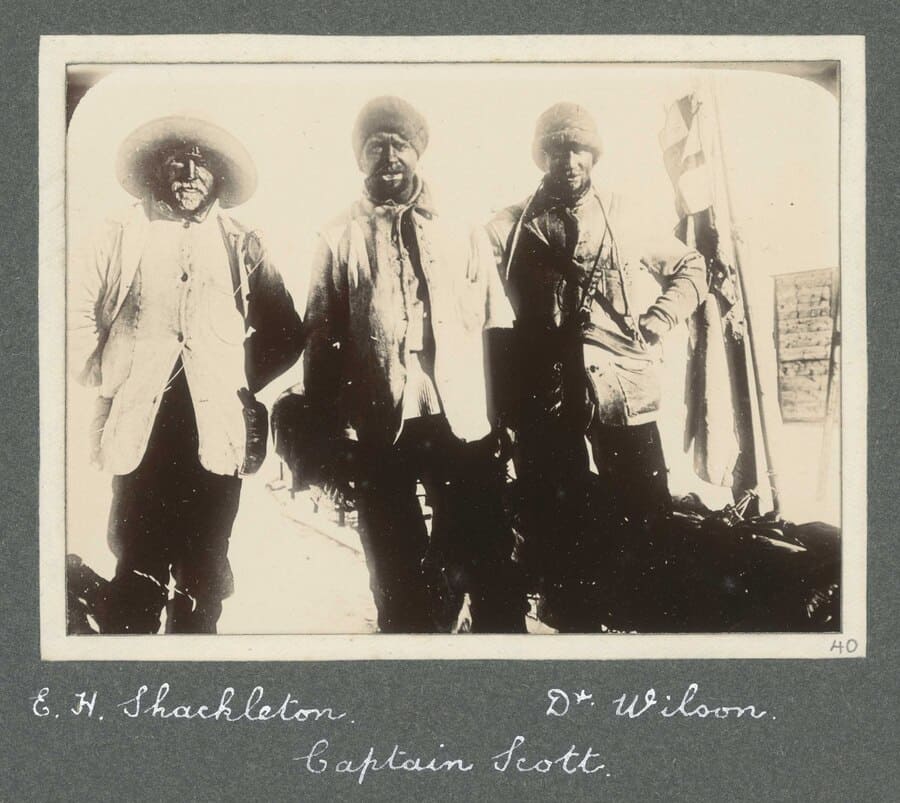
Scott’s return to England
The Antarctic Plateau is the ice sheet that stretches for thousands of kilometers around the South Pole, mainly in East Antarctica, at an elevation of more than 3,000 meters above sea level. The plateau area is the coldest on the planet, experiencing extremely low temperatures for long periods, as low as nearly -80 degrees Celsius. The cold winds that blow permanently make this the most inhospitable place for all forms of life, including viruses and bacteria. However, the polar cap has a very important function on the planet’s climate, already acting as a natural and permanent generator of cold air that contributes to the formation of the climate of the Southern Hemisphere and the entire Earth.
The expedition also collected many geological samples, and findings of biological and zoological interest.
Finally, to free the Discovery, two ships rushed in, and with explosives, it was possible to free the ship from the ice and undertake the return voyage.
The Discovery returns to England in September 1904. Scott was greeted as a hero. His feat captured the popular imagination. He receives countless awards, both at home and in other countries. He is further promoted and becomes a naval captain. King Edward VII invites him to court and appoints him a Commander.
Scott’s life undergoes a 360-degree change. Now Scott is being courted in the good salons of Europe and is connected with important people. After his return home, he spends nearly 2 years, traveling the world, writing a book on the Discovery expedition, lecturing and cultivating public relations.

Scott’s marriage and a new expedition
During this period, Scott meets his future wife, Kathleen Bruce. Kathleen is a highly educated woman; she is a recognized and highly regarded sculptor whose circle of acquaintances includes such well-known artists as Pablo Picasso and Isadora Duncan. Scott has to work hard to win his Kathleen, who has no shortage of suitors. Finally, after much insistence, Scott succeeds in winning his beloved, with whom he will tie the knot in September 1908. And exactly one year later, in September 1909, their only son, Peter Markham Scott, was born.
In early 1909, Scott announced a new Antarctic expedition. At that time, Scott was holding an important post in the London Admiralty. But perhaps this did not sufficiently gratify him. Polar expeditions occupied the imagination of public opinion at the time, and the conquest of the Poles was considered a highly prestigious undertaking for the nations concerned.
The two companies that had funded the previous expedition did not seem interested in doing it again. Therefore, Scott begins a fundraising campaign at his contact circuit and places ads in newspapers to collect bids. The estimated cost of the expedition was 40,000 pounds. Scott obtains state funding of £20,000, and the remaining £20,000 is raised through donations from sponsors, both cash and in-kind. Scott devotes his heart and soul to fundraising, meetings with corporate sponsors and private donors. Fundraising continues even after the voyage has begun, holding events at every port visited on the route to Antarctica.
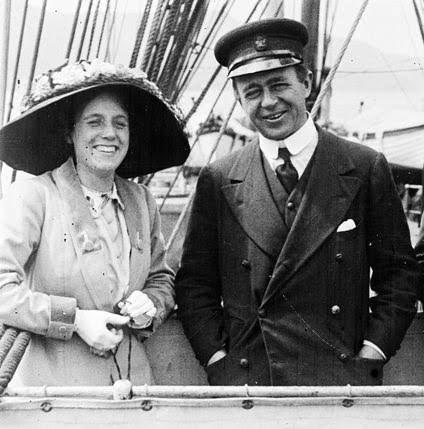
Preparing for the new expedition
The sum of 40,000 pounds may seem small, but if we make a comparison between consumer prices at that time and today, we see that the 40,000 pounds then is equivalent to more than 6,000,000 pounds today.
The most important investment Scott wants to make is the purchase of the whaling ship Terra Nova, which has a cost of 12,500 pounds. This is one of the ships that came to Scott and Discovery’s rescue on the previous expedition, helping him clear the ice.
The Terra Nova crew that is chosen by Scott consists of 65 men, 50 of whom are military personnel. Also present are highly trained scientists specializing in geology, biology, physics, and zoology. Also in the group is a photographer, Herbert Ponting, who will be in charge of photo shoots and films.
Scott assigns some of his staff to make major purchases related to transportation. He sent one of his men to Siberia to buy sled dogs, and while the latter was on site, he let him know to buy horses as well. The appointee was knowledgeable about dogs, however, but he did not know much about horses. He bought 34 dogs and 19 ponies, and unfortunately, the latter did not prove up to the task.
Scott also bought motorized sleds that he planned to use as an alternative means of transportation to the dogs and horses, but unfortunately, this was not a good idea, as it later had to be found that they were not suitable for the climate of Antarctica because they froze and became unusable.
If Scott’s first expedition had been motivated primarily by scientific reasons, instead for Scott this second expedition has as its primary goal the conquest of the South Pole and he ardently wants to be the first man to reach it.
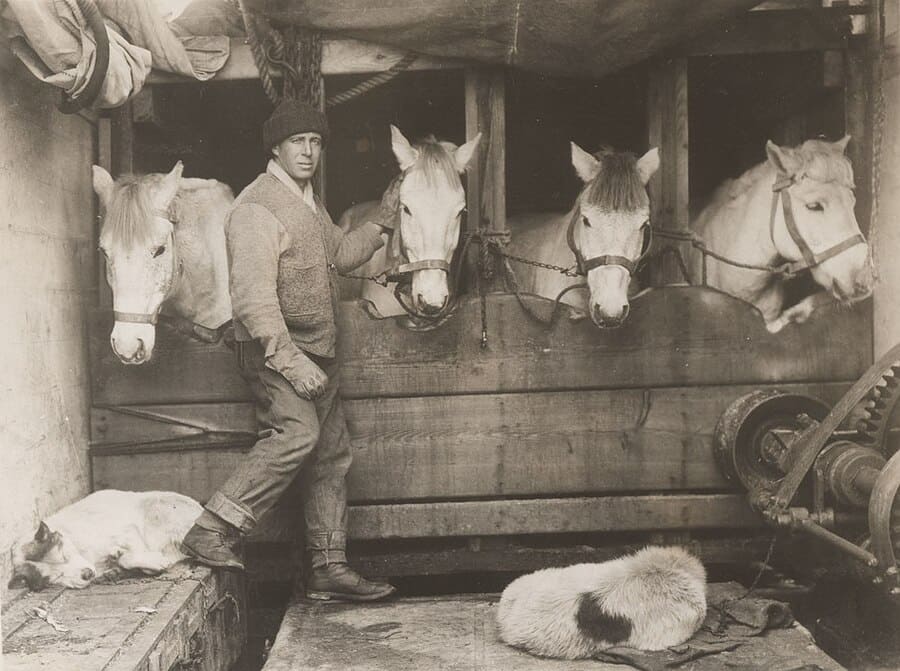
Initial setbacks
The South Pole is an abstract place that has nothing to differentiate it from its surroundings; however, its latitude of 90 degrees south represents something symbolic in the collective imagination. In addition, Scott strongly desired to be remembered forever for accomplishing this great feat that would bring great honors to him and his country.
However, Scott was not the only one who aspired to reach the South Pole first. When the Terra Nova arrived in Australia, Scott received a telegram from Amundsen informing him that he was traveling to the South. A low blow for Scott, who when he had left England had not counted on having to compete with someone else.
Unfortunately, for Scott, the setbacks begin already on the voyage between New Zealand and Antarctica. A storm surprises them at sea and the ship is flooded with water. The Terra Nova’s pumps do not work and the crew must dispose of the water with buckets. As a result of this accident 2 horses, a dog, and two tons of coal are lost. A few days later the ship is trapped in the ice for 20 days, and this fact will cause a delay on the work schedule.
They finally arrive at Ross Island. The work plan is to build the camp that will serve as the group’s base. At the same time, some working groups are to set up stores of food and necessities in Ross Barrier, which will be used for supplies for the expedition returning from the South Pole.
As for Terra Nova, it would not stay in Antarctica during the winter period. It would then return to New Zealand and then return in the next Antarctic “summer.”
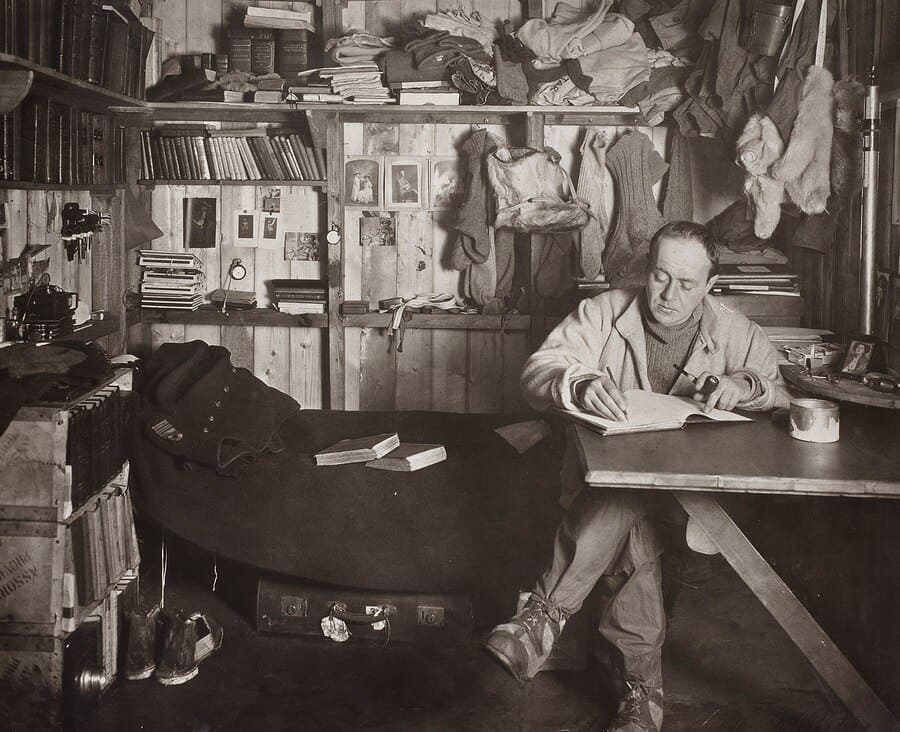
The departure for the South Pole
Because of the time lost to the initial setbacks, the group entered a bit of a slump. Scott himself, in the process of establishing the food depot on the Ross Barrier, budgeted at a latitude of 80 degrees, seeing that the horses would not make it, decided to place the depot at a lower latitude of only 79 degrees 29′, a 54km shift from the planned point. This decision did not prevent the death of the horses, which died on the way back anyway, but unfortunately, it was a decision that had a fatal consequence the following year, for him and those with him.
In early September 2011, Scott mapped out his plan and communicated it to his team. The round trip route measured a total of 2842 km. At the start of the trip, there would be 16 men, who, upon reaching set milestones, would be climbed by 4 men going back, until there would be only 4 left who would travel the last leg to the South Pole. The duration of the journey between round trip was estimated to be 144 days.
On October 24, the team traveling with snowmobiles, set off with a load of food and equipment with the goal of getting up to 80 degrees and 30’S and to stand by waiting for the other team to join them. But unfortunately, the snowmobiles break down almost immediately, having covered only 87 km. At that point, the men have to take it upon themselves to carry the 331 kg of luggage under their own power, so they arrive at the rendezvous point two weeks late.
The group regroups and resumes the trek, but bad weather forces them several times to stop even for several days, waiting to be able to start again.

The great disappointment at the South Pole
One of the most difficult passes was Beardmore Glacier, extremely dangerous, full of crevasses, and with its 3,000-meter altitude. It took them 11 days to climb the glacier and finally, on January 4, 1912, having arrived at a latitude of 87degrees and 32’S, Scott chose those who would be the men who besides him would continue the trek to the South Pole: Edward Adrian Wilson, Lawrence Oates, Henry Robertson Bowers y Edgar Evans. Scott in return for choosing 3 men as planned, chooses 4, despite the fact that food supplies were carefully planned for a total of 4 men.
So the group of 5 men continues southward, passes the 88 degree 23’S altitude at which Shackleton had arrived 3 years earlier, only 180 km from the South Pole. On January 17, 1912, they finally reach the Pole and there they encountered a tent with a Norwegian flag. They realize that Amundsen has preceded them and the disappointment is immense. Scott writes in his diary, “The worst has happened…The Norwegians got ahead of us…Tomorrow we will return to base as soon as possible.”
Amundsen had left some gear and a letter for Scott saying the following:” Dear Commander Scott, since you will probably be the first to arrive after us, may I ask you to send the enclosed letter to His Majesty Haakon VII? If the equipment left in the tent can be of use to you, please feel free to make use of it. To my best regards, I join my best wishes for your safe return. Yours sincerely, Roald Amundsen.”
They noted that Amundsen had left 12 days before them and had made the trip in only 57 days, while they had taken 79 days.

Return from the South Pole: the final tragedy
On the return trip, a month later, on February 17, 1912, the group finished their descent of the Beardmore Glacier. Edgar Evans has fallen several times on the ice, suffered various injuries, and is at the end of his strength after 3 months of inhuman effort and inadequate nutrition. He died the same day.
A month later, on March 17, 1912, we find Scott and his men stranded for days by an intense blizzard and a temperature of -40 degrees at noon, preventing advance. Food supplies are very low, the next food depot is only a little over 17 km away, but bad weather prevents them from moving. Lawrence Oates, who is in great pain from a frozen foot, comes out of the tent and says, “I’m going to go out here and I might stay for a while” He walks away and his body will never be found.
On March 23, Scott notes in his diary, “Fuel is exhausted and we have only one or two food rations left. It has been decided to end it naturally: we will leave for the depot, with or without the equipment, or die on the way.” But the men are too weak and cannot even get out of the tent. On March 29, 1912, Scott notes his last words in his diary, “We are obviously getting weaker and weaker and the end cannot be far off. It is a pity but I don’t think I shall be able to write any more. For God’s sake, take care of our families.”
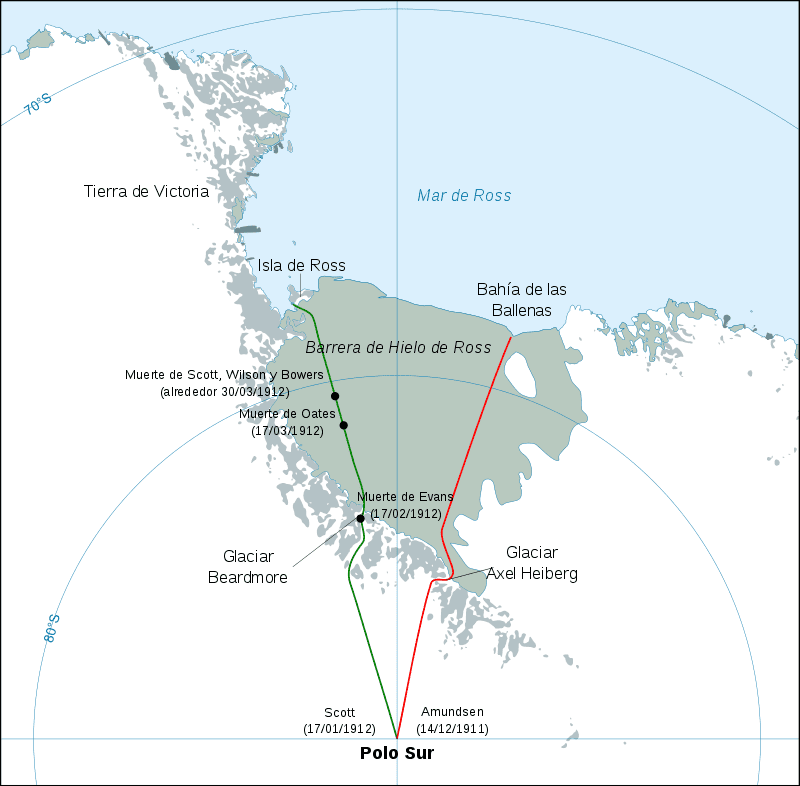
Popular commotion over Scott’s death
Eight months later, in November of the same year, a rescue team will find the tent with the 3 bodies, Scott’s diary, camera, various geological samples, and various letters inside. The tent in which they are found is folded over their bodies, and then covered with ice on which a cross is placed.
Scott loved to write and was gifted with good prose. When his diary is made public, it creates great emotion and helps create the heroic myth of the character.
His final appeal in which he asks them to take care of their families also has a great impact on public opinion. 75,000 pounds is raised, which benefits the families of the victims. Scott’s widow, son, mother and sisters are paid a total of 18,000 pounds. The rest is apportioned to the families of the other victims, payment of the remaining debts of the expedition, and the costs of publishing Scott’s diary.
In the years that followed, several monuments were erected in Scott’s memory. Notably, one of these was sculpted by Scott’s widow Kathleen Scott in 1915, and is located in Portsmouth Harbor.
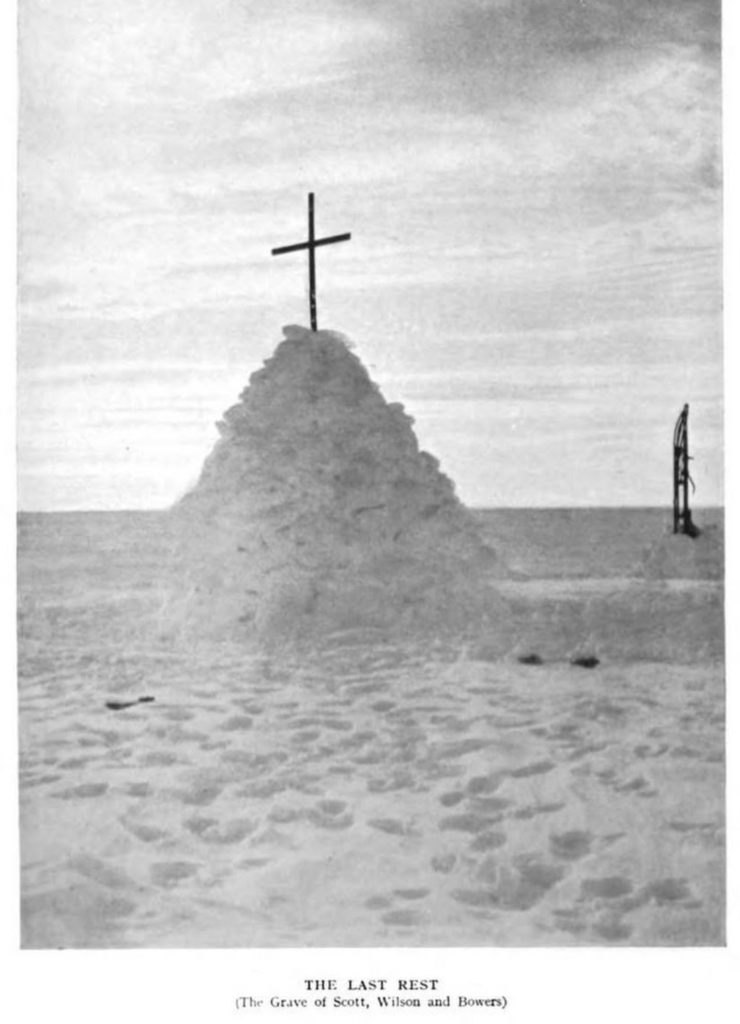
2012: The centenary of Scott’s expedition
In 2012, to mark the centenary of Robert Falcon Scott’s arrival at the South Pole, commemorations and events were held in England and around the world. Over the years, feelings toward Scott’s adventure, have been changing. After the initial period of emotion, a more critical judgment has taken hold, blaming Scott for a number of errors of which 3 would prove to be extremely prejudicial.
1. There was much criticism of the choice to bring Siberian horses as well, instead of bringing only dogs. In Siberia, ponies have paddles attached to their legs to walk in the snow. Instead, the expedition forgot the paddles in Evans’ base, so the poor animals, being heavy, sank their paws completely into the snow and soon collapsed from fatigue. In addition, horses sweat a lot, and the sweat became a sheet of ice stuck to the body. Finally, the food ration that the expedition had to carry with them on the sled to feed the ponies was much heavier and bulkier than the dog food ration.
2. The choice of snowmobiles was not apt either. It is said that the cause of the sleds’ malfunction was not the cold weather, but rather the very low octane fuel that Scott had sent to buy.
3. Scott and his men would not have starved to death if they had placed the food depot at the predetermined point at the latitude of 80 degrees. If they had done so, they would have had enough food to wait out the blizzard.
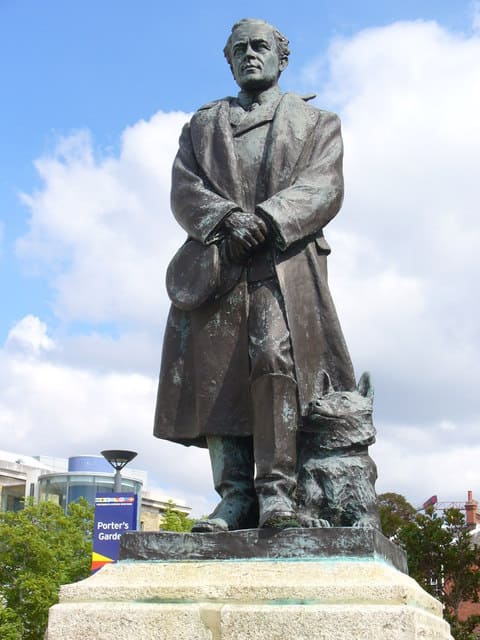
Kathleen Scott in 1915
Scouts would have needed better nutrition
But comments have also been heard that de-emphasize Scott and his men. According to meteorology expert Susan Solomon, known for her studies of the ozone hole over Antarctica, the months of February and March 1912 would have seen extraordinarily low temperatures that have been repeated only one other time in the same century. Therefore, Scott’s team truly had encountered insuperable difficulties. Instead, Amundsen, who had a month’s head start, managed to accomplish his mission in a window of time when weather conditions were much less extreme.
Much has also been said about the diet of the explorers and how poorly it was adapted to the extreme climate and the enormous physical exertions they were subjected to.
According to modern nutritionists, the diet of Scott and his explorers should have included many more carbohydrates and foods with vitamin C. Carbohydrates maintain blood sugar levels and give more energy. They should have consumed at least 6,000 calories daily. Instead they ate mostly seal and penguin meat and occasionally roast beef that they had brought from England. And after spending a few months in Antarctica, they were increasingly hungry and obsessed with food. In addition, because of the lack of vitamin C, they often fell ill with scurvy. If the explorers had had proper nutrition, surely they could have faced their enormous labors in better physical and mental condition.

